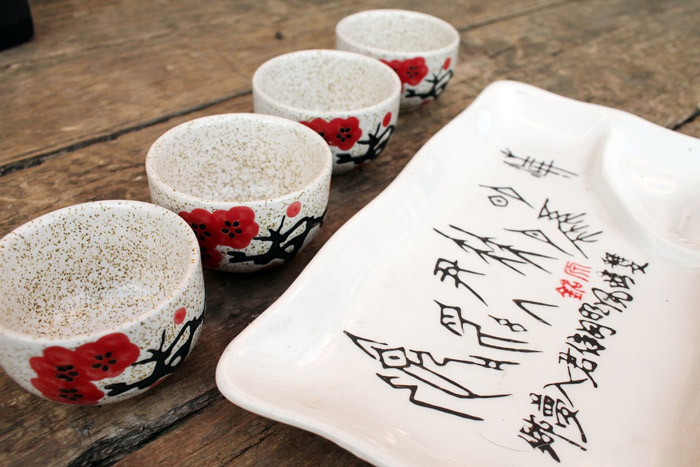
Before we explore the optimal drinking temperature, it's essential to understand what sake is and how it's made. Sake is a fermented rice beverage produced primarily from polished rice, water, yeast, and koji mold. The quality of sake is influenced by factors like the type of rice, the water source, and the brewing process. The flavor profile of sake can range from light and floral to rich and complex, depending on these variables.
Temperature plays a pivotal role in the way flavors and aromas are perceived in any beverage, and sake is no exception. Different temperatures can accentuate or mute certain characteristics of sake, making the choice of serving temperature a critical aspect of the sake-drinking experience.
The Five Temperature Ranges
Sake can be enjoyed at a wide range of temperatures, but it is generally categorized into five temperature ranges: chilled, cool, room temperature, warm, and hot. Each of these temperature ranges brings out distinct qualities in the sake, allowing you to tailor your experience to your preferences and the specific sake you're enjoying.
Chilled Sake (5°C - 10°C / 41°F - 50°F)
Chilled sake, known as "reishu" in Japanese, is often considered the default serving temperature for sake. This range enhances the clean and crisp aspects of the drink, making it ideal for lighter sakes like Ginjo and Daiginjo. Chilled sake is refreshing and can reveal delicate floral and fruity notes, making it perfect for hot summer days or as an aperitif.
Cool Sake (10°C - 15°C / 50°F - 59°F)
Cool sake, or "hiya," is a step up in temperature from chilled sake. This temperature range is suitable for a broader range of sake types, including Junmai and Honjozo. It can bring out a more balanced flavor profile, allowing the drinker to appreciate both the sake's subtle nuances and its umami notes. Many people find this temperature range to be an excellent starting point when exploring sake.
Room Temperature Sake (15°C - 20°C / 59°F - 68°F)
Room temperature sake, called "joon" in Japanese, is enjoyed at a temperature similar to that of red wine. It is an excellent choice for exploring the complexity of aged or matured sakes. The warmer temperature allows the sake to open up, revealing its full range of flavors and aromas. Richer sakes, such as Junmai and Yamahai, are often best enjoyed at room temperature.
Warm Sake (40°C - 50°C / 104°F - 122°F)
Warm sake, or "kan," is a traditional and comforting way to enjoy sake, especially during the colder months. Warming sake can mask some of its more aggressive flavors while emphasizing its sweetness and umami. It is an excellent choice for medium-bodied sakes like Junmai and Honjozo. The gentle warmth can enhance the overall drinking experience and pair well with various Japanese dishes.
Hot Sake (50°C and above / 122°F and above)
Hot sake, known as "atsukan," is served at a higher temperature than warm sake and is the warmest option available. It's worth noting that extremely high temperatures can overpower the sake's delicate characteristics and make it taste more alcoholic. Hot sake is typically enjoyed in winter and pairs exceptionally well with hearty, savory dishes. In Japan, it's often served in small ceramic or glass cups known as "choko."
Choosing the Right Temperature
Selecting the optimal drinking temperature for sake can greatly enhance your enjoyment of this remarkable beverage. Here are some tips to help you make the right choice:
Consider the Sake Type: Different types of sake are better suited to specific temperature ranges. Light and aromatic sakes like Ginjo are typically enjoyed chilled or cool, while more robust sakes like Junmai and Honjozo can be enjoyed at warmer temperatures.
Experiment: Don't be afraid to experiment and find the temperature that suits your palate best. You may discover that you prefer a certain sake served slightly warmer or cooler than the conventional recommendations.
Take the Season into Account: Consider the season and the weather when choosing your sake's temperature. A warm sake may be more comforting during the winter, while a chilled sake is perfect for a hot summer day.
Balance with Food: Think about what you're planning to eat alongside your sake. The temperature of your sake should complement the flavors and textures of your meal. For instance, chilled sake can be a refreshing contrast to spicy dishes, while warm sake pairs well with heartier fare.
Use the Right Glassware: The choice of glassware can also impact your sake experience. Smaller cups or glasses can help retain the temperature, while larger vessels can allow the sake to warm up more quickly.
The optimal drinking temperature of sake is a subjective choice that depends on your preferences and the sake you're enjoying. By understanding the five temperature ranges and how they affect the flavor and aroma of sake, you can tailor your drinking experience to suit your mood and the occasion. Whether you prefer the refreshing notes of chilled sake on a summer evening or the comforting warmth of hot sake during the winter, the versatility of sake allows you to explore and appreciate its rich and diverse flavors at any temperature.